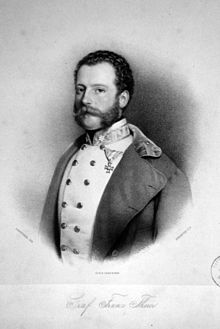Franz von Thun and Hohenstein (officer)
Franz Graf von Thun and Hohenstein (born July 27, 1826 in Choltitz , Bohemia , † July 30, 1888 in Schwaz , Tyrol ) was an Austrian officer . He was in command of the Austrian Volunteer Corps in Mexico and general of the Imperial Mexican Army .
Military career
On April 11, 1844, he joined the 28th Infantry Regiment as a cadet , where he was soon made lieutenant and transferred to IR No. 1 in the Italian Army by Field Marshal Radetzky . As a captain , he took part in the street fighting in Milan from March 18 to 22, 1848 and was praised for his exemplary behavior in the army report.
After the outbreak of the Vienna October Uprising in 1848 , the regiment was transferred there to help in the suppression. Thun and Hohenstein was awarded the Military Merit Cross for his courageous behavior when storming the city . After the regiment was transferred back to the Italian theater of war, he took part in the Battle of Novara on March 23, 1849 and was wounded. Mentioned several times in the army reports because of his behavior, he was promoted to major and assigned to Field Marshal Radetzky's staff.
In the Sardinian War of 1859 he was wounded again as commander of a grenadier battalion in the battle of Solferino on June 24, 1859. For the excellent leadership of his troops he was awarded the Knight's Cross of the Leopold Order with war decoration. With effect from July 1, 1859, he was promoted to lieutenant colonel. He then took over the 9th Infantry Regiment as commander and was promoted to colonel .
In 1864, at the personal request of Emperor Maximilian of Mexico , Thun and Hohenstein was appointed commander of the Austrian volunteer corps in Mexico . As the current general of the Imperial Mexican Army, he took over command of the 2nd Mexican Territorial Division, which, in addition to the Austrian volunteer corps, also included the two Belgian volunteer battalions under Lieutenant Colonel Alfred van der Smissen . Despite considerable success, for which he was awarded the Commander's Cross of the Guadalupe Order , he soon came into conflict with the commander-in-chief of the French intervention forces, François-Achille Bazaine . Likewise dropped by the emperor, he resigned his service in August 1866 and returned to Austria.
Re-accepted into the Austrian army , he was promoted to major general in 1867 and three years later appointed commander of the 8th Troop Division. In 1873 he was promoted to field marshal lieutenant and commander of the 8th Infantry Troop Division , and in 1882 to Feldzeugmeister and military commander of Tyrol.
In 1877 he married Auguste-Eugenie Princess of Urach. In bad health he was retired on January 1st, 1887. He died on July 30, 1888 in Schwaz in Tyrol.
Appreciation
Franz Graf von Thun und Hohenstein is a classic representative of the generation of officers who began their careers as regimental cadets and rose to the highest ranks and command posts due to their military service in the war. For his failure in Mexico, the scheming management style of Bazaine and the lack of support from Maximilian were primarily responsible. Ultimately, however, the latent financial crisis of the Mexican Empire and its lack of opportunities were decisive. As a military commander in Tyrol, he also earned the highest services to the civil authorities, who appreciated his active support during the flood disaster of 1882/83 and recommended him for the award of the Franz Joseph Order .
literature
- Constantin von Wurzbach : Thun-Hohenstein, Franz . In: Biographisches Lexikon des Kaiserthums Oesterreich . 45th part. Imperial-Royal Court and State Printing Office, Vienna 1882, p. 21 ( digitized version ).
- A. Schmidt-Brentano: Thun and Hohenstein Franz Gf. from. In: Austrian Biographical Lexicon 1815–1950 (ÖBL). Volume 14, Verlag der Österreichischen Akademie der Wissenschaften, Vienna 2012–, ISBN 978-3-7001-7312-0 , p. 321 f. (Direct links on p. 321 , p. 322 ).
Web links
- Biography with photos (English)
| personal data | |
|---|---|
| SURNAME | Thun and Hohenstein, Franz von |
| ALTERNATIVE NAMES | Thun and Hohenstein, Franz Graf von |
| BRIEF DESCRIPTION | Austrian general |
| DATE OF BIRTH | July 27, 1826 |
| PLACE OF BIRTH | Choltice , Bohemia |
| DATE OF DEATH | July 30, 1888 |
| Place of death | Schwaz , Tyrol |

